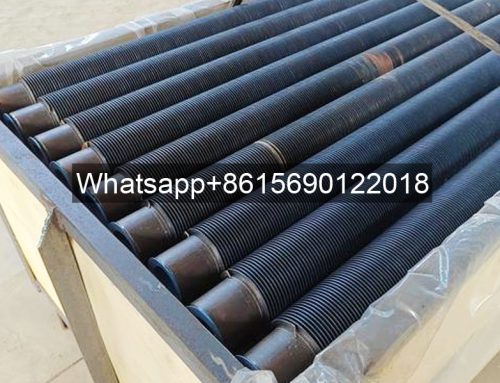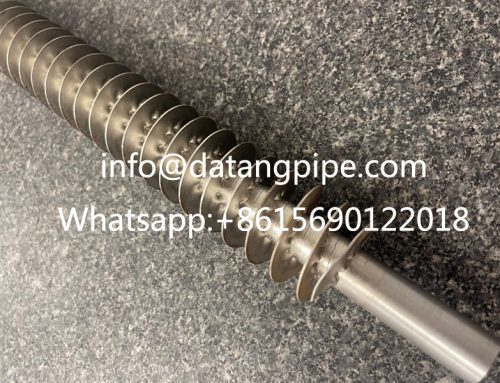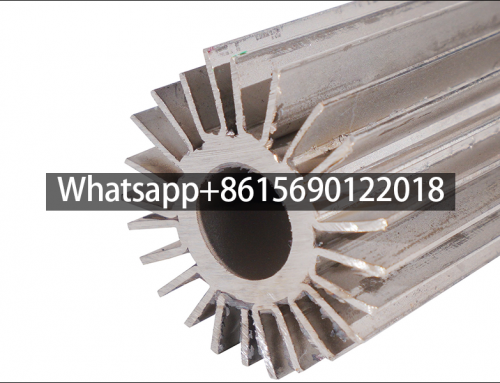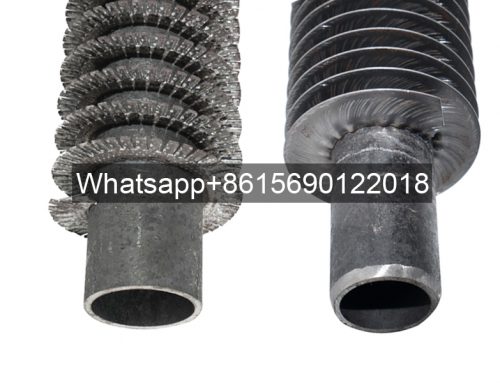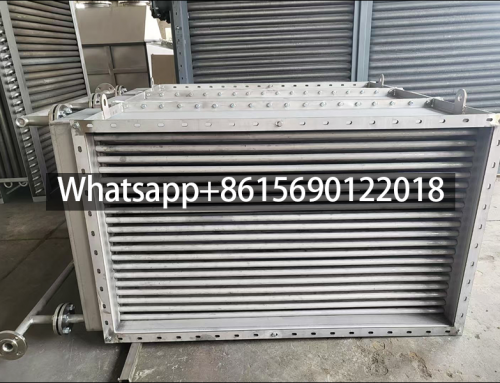Optimized Greenhouse Thermal Management: Hot-Dip Galvanized Finned Tubes
Structural and Functional Design
Hot-dip galvanized finned tubes constitute precision-engineered heat exchange systems for modern greenhouse operations. Constructed from seamless steel pipes (Schedule 40/80), they incorporate spiral aluminum fins (0.3-0.5mm thickness) welded via high-frequency processes. The integrated fin geometry increases heat transfer surface area 8-10× compared to bare pipes. Post-fabrication hot-dip galvanization creates a zinc-iron alloy coating (min. 80μm) that provides sacrificial corrosion protection in humidity levels up to 95% RH.
Thermal Transfer Mechanism
- Heat Absorption: Thermal fluid (water/glycol mixture at 60-85°C) circulates through the core pipe
- Conduction: Thermal energy transfers from fluid to pipe wall through conduction
- Fin Dissipation: Fins amplify heat radiation to surrounding air (+25-30% efficiency vs. smooth tubes)
- Convection: Natural airflow or supplementary fans distribute warmth across the canopy
Performance Advantages
Superior Thermal Regulation
- Achieves temperature uniformity (±1.5°C across 30m span)
- Rapid response: 15-20 minute recovery after ventilation events
- Maintains optimal root-zone temperatures (18-25°C)
Durability in Humid Environments
| Parameter | Specification | Industry Standard |
|---|---|---|
| Zinc Coating | 80-120 μm | ASTM A123 |
| Corrosion Resistance | >15 years lifespan | ISO 9227 |
| Operating Pressure | ≤1.6 MPa | ASME B31.1 |
| Temperature Range | -30°C to 180°C | EN 10240 |
Operational Efficiency
- 30-40% fuel savings vs. forced-air heaters
- Compatible with solar thermal inputs (40-60°C)
- Maintenance limited to annual compressed air cleaning
Smart Greenhouse Integration
IoT-Enabled Climate Control
- Sensors monitor:
- Soil moisture (10-40 kPa matrix potential)
- Leaf temperature (±0.5°C accuracy)
- VPD (0.3-1.5 kPa range)
Cross-System Synergies
- Irrigation Integration: Pre-warms irrigation water to 20-25°C
- CO₂ Enrichment: Maintains optimal gas solubility during heating cycles
- Dehumidification: Condensate capture reduces humidity spikes
Future Development Trajectory
Emerging Technologies
| Innovation Area | Development Status | Potential Impact |
|---|---|---|
| Phase Change Materials | Lab validation | 40% energy storage |
| Graphene Coatings | Prototype testing | 25% conductivity ↑ |
| AI Predictive Control | Commercial rollout | 15% yield increase |
Sustainability Initiatives
- Carbon-neutral operation through biogas integration
- Recycled steel utilization (>85% content)
- End-of-life zinc recovery (95% reclaim rate)
Technical Specifications Summary
| Category | Parameter | Value/Range |
|---|---|---|
| Structural | Core Pipe Material | ASTM A106 Gr.B |
| Fin Thickness | 0.4±0.05 mm | |
| Fin Density | 160-200 fins/meter | |
| Thermal | Heat Transfer Coeff. | 35-55 W/m²K |
| ΔT Fluid-Air | 25-40°C | |
| Output per Meter | 500-800W @ 70°C | |
| Control | Response Time | |
| Temp Uniformity | ±1.5°C/30m |
This integrated heat exchange solution delivers precision thermal management for year-round greenhouse operations while reducing operational costs by 25-40%. Continuous innovation positions galvanized finned tubes as the backbone of sustainable controlled-environment agriculture.
Introduction to hot-dip galvanized finned tubes for greenhouses
As an important facility in modern agriculture, the stability and regulation of the internal environment of greenhouses are directly related to the growth and yield of crops. In the heating systems of many greenhouses, hot-dip galvanized finned tubes have become an indispensable key component with their high efficiency and durability.
This article will introduce in detail the structure, working principle, advantages and future development trend of hot-dip galvanized finned tubes for greenhouses, in order to provide valuable reference for agricultural practitioners.
The structural characteristics of hot-dip galvanized finned tubes are significant. It is mainly made of seamless steel pipes. The fins are tightly welded to the steel pipes through high-frequency welding technology to form a finned tube structure. The design of the fins greatly increases the heat exchange area and improves the heat exchange efficiency.
Finned tubes are usually made of steel and are hot-dip galvanized. This treatment not only enhances the corrosion resistance of the finned tubes, but also effectively resists mechanical damage during transportation and use, and prolongs the service life.
In greenhouses, the main function of hot-dip galvanized finned tubes is to transfer heat to the fins through the circulation of the heat medium in the tube, and then dissipate the heat into the greenhouse through the fins, thereby increasing the temperature in the greenhouse.
When the heat source generates heat, the heat is first transferred to the finned tube. As the core component of the radiator, the unique fin design of the fin allows the heat to be quickly dissipated into the air.
As the heat is conducted, the heat medium in the finned tube transfers the heat to the heat sink, and the fin structure on the heat sink further increases the heat dissipation area and accelerates the heat dissipation. The auxiliary effect of natural convection or fans allows air to flow through the heat sink, taking away the heat and dissipating it into the surrounding environment, thereby achieving efficient heat dissipation.
The application of hot-dip galvanized finned tubes in greenhouses has significant advantages.
1. Its efficient heat transfer characteristics enable the greenhouse to maintain a suitable growth temperature even in cold seasons, creating an ideal growth environment for crops. This heat exchange method has the characteristics of high heat transfer efficiency and uniform heat dissipation, which can quickly increase the indoor temperature and keep the temperature stable.
Especially in cold winter or areas with large temperature difference between day and night, hot-dip galvanized finned tubes are like warm guardians, providing the necessary growth conditions for crops and ensuring the yield and quality of crops.
2. Hot-dip galvanized finned tubes have strong corrosion resistance and long service life.
The greenhouse environment is humid and changeable, and ordinary materials are susceptible to corrosion and damage. The hot-dip galvanizing treatment effectively enhances the corrosion resistance of the finned tube, prolongs the service life, and reduces maintenance costs. This makes hot-dip galvanized finned tubes an ideal heating equipment in greenhouses, capable of long-term stable operation in harsh environments.
3. Hot-dip galvanized finned tubes also have the advantages of easy installation and simple maintenance.
Its modular design makes the installation process quick and convenient, and it is also convenient for future maintenance and replacement, reducing the labor intensity of farmers.
At the same time, its high heat conversion efficiency also means lower energy consumption, which is in line with the development trend of energy conservation and emission reduction in modern agriculture.
With the continuous advancement of agricultural technology, hot-dip galvanized finned tube radiators for greenhouses are also constantly innovating and upgrading. For example, the introduction of the intelligent temperature control system makes the operation of the radiator more accurate and efficient, and can automatically adjust the heat dissipation according to the real-time temperature in the greenhouse to achieve refined management.
In the actual application of greenhouses, the combination of hot-dip galvanized finned tubes and other agricultural facilities also shows strong advantages.
For example, it can be combined with the irrigation system to monitor soil moisture and temperature through the intelligent temperature control system, automatically adjust the irrigation amount and heat dissipation, and provide a suitable growth environment for crops.
It can also be combined with the ventilation system to automatically adjust the ventilation volume according to the air quality and temperature in the greenhouse to keep the air in the greenhouse circulated and fresh. This multifunctional integration and optimization makes the management of greenhouses more intelligent and efficient.
With the further development of agricultural Internet of Things technology, hot-dip galvanized finned tubes and their supporting greenhouse heating systems will become more intelligent and integrated. Through remote monitoring and control, farmers can grasp the dynamics of the greenhouse anytime and anywhere, adjust management strategies in time, and achieve precision and efficiency in agricultural production.
For example, through the Internet of Things technology, farmers can monitor the temperature, humidity, light intensity and other environmental parameters in the greenhouse in real time, and adjust the heating power and working time of the hot-dip galvanized finned tube according to these data to achieve the best growth environment.
With the improvement of environmental awareness, hot-dip galvanized finned tubes will also pay more attention to energy conservation and emission reduction. Adopt more environmentally friendly manufacturing processes and materials to reduce energy consumption and environmental pollution, and promote the development of green agriculture.
For example, develop new heat conduction materials to improve the heat conduction efficiency of hot-dip galvanized finned tubes and reduce energy consumption; or use renewable energy as a heat source, such as solar energy, geothermal energy, etc., to achieve sustainable heating of greenhouses.
In terms of technological innovation, the materials and processes of hot-dip galvanized finned tubes will also be continuously optimized and upgraded.
For example, develop new fin structures to further improve heat exchange efficiency; or use advanced welding technology to improve the connection strength between fins and base tubes to ensure rapid heat transfer and uniform distribution. These technological innovations will make the application of hot-dip galvanized finned tubes in greenhouses more extensive and popular.
Hot-dip galvanized finned tubes for greenhouses play an irreplaceable role in modern agriculture with their high efficiency, durability and easy maintenance.
It can not only provide a suitable growth environment for crops and ensure the yield and quality of crops; it can also be combined with other agricultural facilities to achieve multi-functional integration and optimization; at the same time, with the continuous development of agricultural Internet of Things technology and the improvement of environmental awareness, the application of hot-dip galvanized finned tubes will be more intelligent and green.
In the future, hot-dip galvanized finned tubes will become an indispensable part of the modern agricultural greenhouse environment, contributing more to the sustainable development of agriculture.


